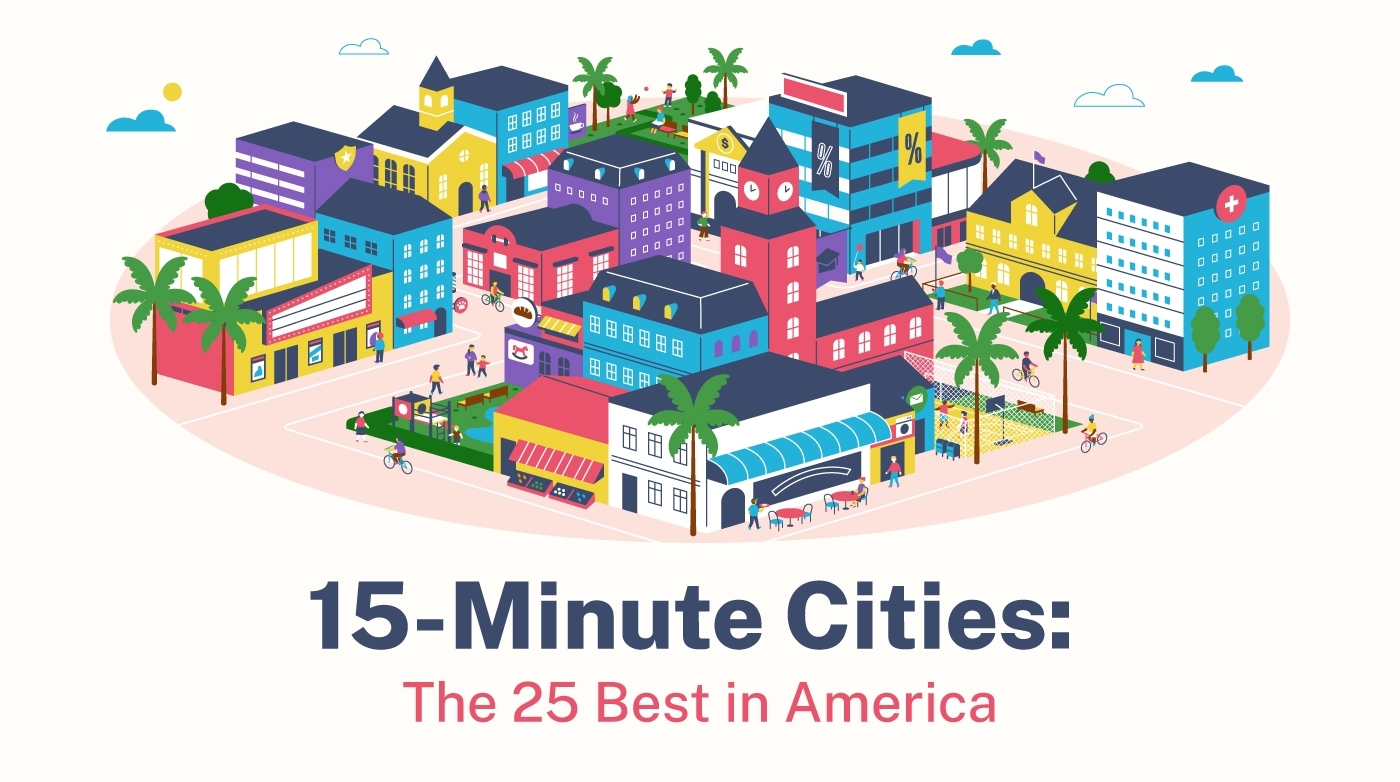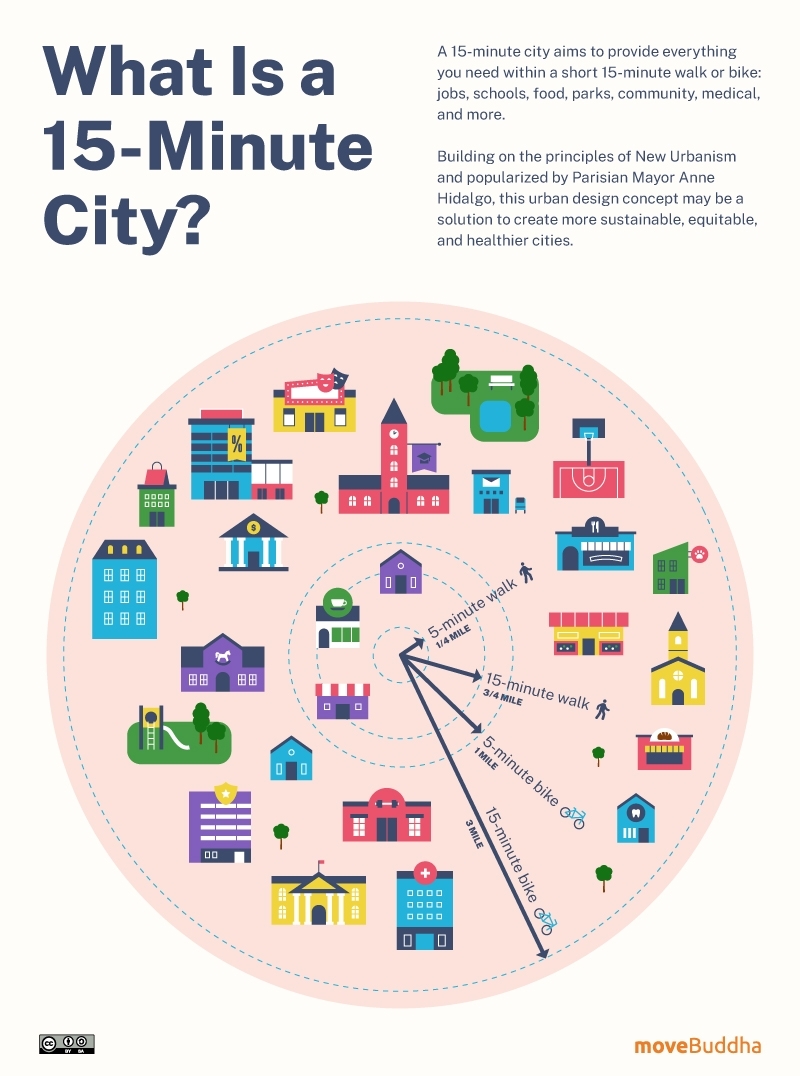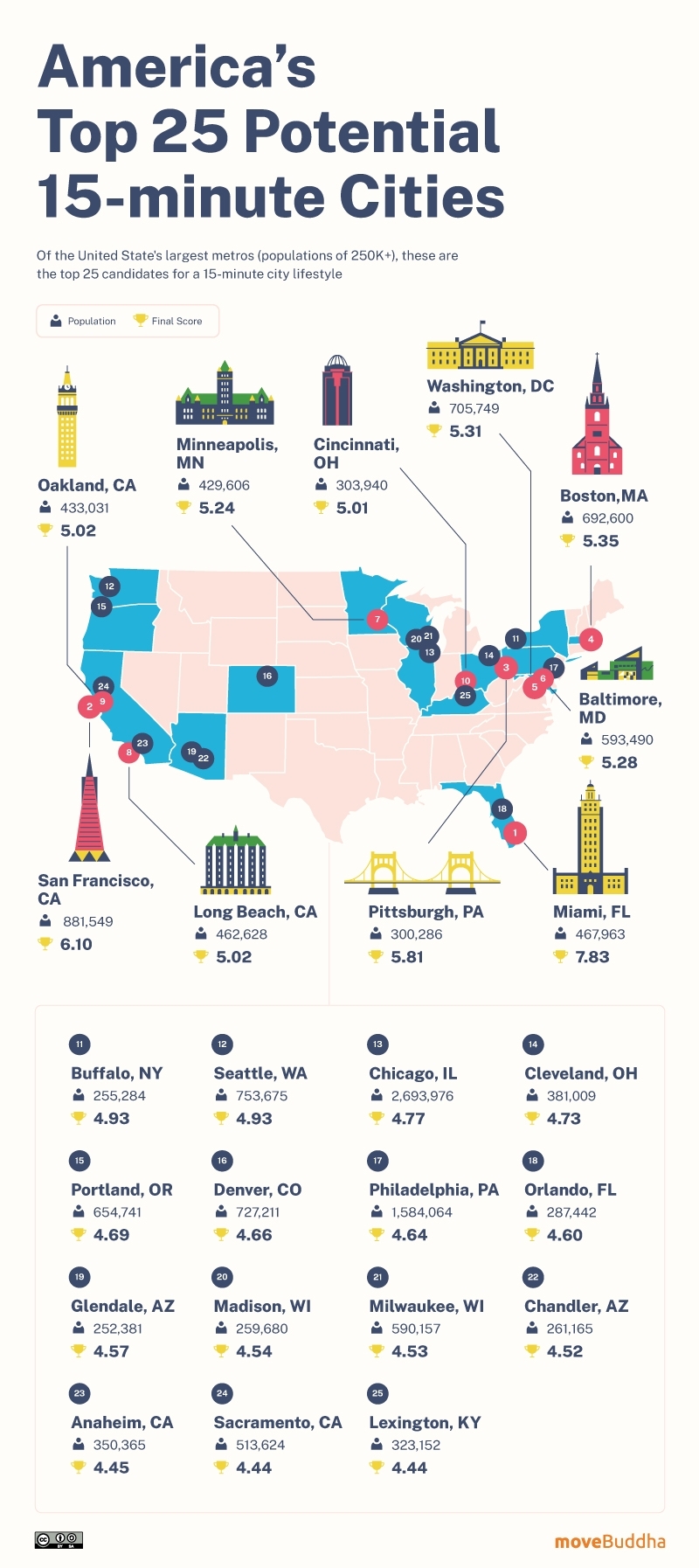Where are 15 Minute Cities Most Viable in the US?
Pandemics are tragic and scary. However, they often highlight opportunities to meaningfully improve urban living for individuals and the community.
For instance, the 1793 yellow fever outbreak in Philadelphia launched city-wide clean-up initiatives and the installment of a waterworks system.
Don’t forget the short-term environmental shift following the initial 2020 pandemic shutdown: China’s carbon emissions fell 25%, clear water ran through Venice canals, and many cities typically clouded with smog realized they had mountains within view.
Today, many city planners and dwellers are drawing from lessons learned during COVID-19 to design new urban landscapes. Ideas range from streets transformed into pedestrian promenades to digitally optimized town centers.
One popular concept hailing from Paris is the 15-minute city.
It’s a city in which, wherever you live, everything you need is located within a 15-minute walk or bike ride away.
While European in concept, many American cities such as Portland, Detroit, and Seattle are also looking for similar solutions. They endeavor to rebuild their cities into walkable, bikeable, and socially connected communities.
Following this concept, we wanted to know: which of America’s largest cities have the greatest potential for transitioning into a 15-minute city?
To determine the best 15-minute cities in American, we looked at the nation’s 78 largest metropolitan areas (population 250K+) and collected area data including walk and bike scores, access to dining, safety, child care centers, schools, medical facilities, and more.
Looking to move to one of these cities? Try our free moving cost calculator, and check out the other materials on out site, including recommendations for the best moving companies, moving container companies, and useful moving tips.
Key Takeaways
- Miami, Florida is the best city overall, with a surprisingly high walk and bike score, plus the highest scores for proximity to dining & parks, child care center density, school density, and medical access.
- 21 of the top 25 cities have less than 750K residents, an indication that cities on the smaller side are more viable candidates for 15-minute transformations. Exceptions include Chicago (IL) and Philadelphia (PA).
- Financial accessibility is one of the primary difficulties. 6 of the top 10 cities on our list have home affordability scores lower than 5 (out of 10), indicating more difficulties for those looking to live here.
What is a 15-minute city?
For simplicity, the 15-minute city ideal brings to mind European cities like Amsterdam, Copenhagen, and, of course, Paris.
The simple formula is that everything you need (food, healthcare, schools, green spaces) should be within a 15-minute walk or bike ride from your home.
Some definitions include public transit, but that can present a multitude of discrepancies, especially when evaluating US cities. Most modern American cities were designed with cars in mind, which would make it difficult to adapt the infrastructure for sweeping 15-minute walking and biking accessibility.
Projections suggest that by 2050 around 89% of the US population will be living in cities, and some studies find that changes in urban planning could reduce mortality by an estimated 20%. With this in mind, implementing changes to urban areas that promote health, encourage social interactions and movement, and reduce pollution could reap positive benefits for years to come.
We evaluated the walkability and bike-ability of American cities alongside the density of necessities to uncover the US cities with the most potential for transitioning into a 15-minute community.
America’s Top 25 Potential 15-minute Cities
Our list of cities includes the country’s largest metropolitan areas with populations of 250K+. A quick glance at the top 25 clearly shows that cities with populations between 250-750K are dominating the best-of 15-minute cities.
Two exceptions to this trend are sprawling Chicago, IL, and Philadelphia, PA. Philly urbanists have dreams of banning cars from the city center and transforming streets by planting one million trees. While Philly offers significantly better walking weather than Chicago, if you can face the wind, Chicago is composed of many different neighborhoods that offer opportunities to implement a 15-minute city strategy.
The average walk and bike score for all cities in our analysis sit at a medium 5.9. The top 25 best 15-minute cities all have much better scores, averaging 7.2.
Lexington, KY just makes it into our list coming in right at #25 with an absolute perfect walk and bike score of 10. A relatively small city (323,152 pop), Lexington has a historic downtown and a program in place (Town Branch Commons Corridor Project) for developing and expanding bicycle and pedestrian access across the city. In 2016 the city was awarded $14.1 million to complete the project, and the Town Branch Fund is leading a $50 Million capital campaign.
America’s 10 best 15-minute cities
The top two cities are Miami, FL, and San Francisco, CA. Wasn’t there a migration from one to the other this past year?
Miami may not be the first city you’d suspect as a 15-minute locale, but thanks to a collection of small urban meccas across the city with pedestrian-friendly designs, the transformation is in full swing. Other efforts include projects like the Underline working to repurpose surfaces under the Metrorail into gardens, walking paths, and open-air gyms.
Miami is also home to start-up REEF, building a network of hyper-local urban hubs to connect local residents to local goods and services in cities across the nation.
Less shocking is San Francisco’s feature in the #2 spot. Since 2008 the city has celebrated Sunday Streets, the country’s largest open streets program to encourage public health and community engagement. More recently, the 15-minute city project was created by long-time San Francisco resident and urbanist Dan Luscher to promote the 15-minute city concept and encourage urban transformation.
One limitation we can quickly see for both cities is affordability. Luscher himself observes that exceptionally designed neighborhoods are desirable and rare, which can drive up the cost of living and price out lower-income residents.
That’s where cities like Pittsburgh, Baltimore, Minneapolis, and Cincinnati can offer more affordable options for those who prioritize walkability and bikeability. All four cities have populations under 500K, great access to a wide range of necessities, and, best of all, have housing affordability scores that are much more feasible.
Sold on the idea of moving to a 15-minute city? Consider comparing the costs with our moving cost calculator before deciding. You can get a quote for the moving costs between any two cities in the U.S. in minutes.
Methodology
We compiled data from a range of sources to understand the density and diversity of community services and community amenities for local residents.
We divided each of these into one of 5 categories, to emphasize, commutability, social and physical health, childcare (education), medical health and safety, and home affordability. After grading each factor, we determined the scores on a scale of 1 to 10, with 10 being the best.
Final rankings: First we compiled the factor scores (1-10) within each of the 5 categories into an average score. Then, taking the average of those 5 category scores, we scored all the cities and ranked the scores accordingly.
Cities analyzed
Our analysis was limited to the largest American metropolitan areas. We include all with populations greater than 250K residents, limited to the 78 largest.
Note: We excluded Boise, ID and Louisville, KY for lack of access to the walk and bike scores.
Walk & Bike Score
The walk and bike scores were sourced from WalkScore.com.
Dining, Parks, and Community Score
- Density of Coffee Shops (Google Places API)
- Density of Restaurants (Google Places API)
- Density of Parks (Google Places API)
- Number of Social Associations*
- Labor Force Participation* Size of the area labor force.
- Food Environment Index* Determines access to healthy food.
- Access to Exercise Opportunity* Measures proximity to a location for physical activity.
Childcare
- Density of Child Care Center
- Density of Public Schools
- Density of Private Schools
Health & Safety
- Density of Hospitals
- Density of Nursing Homes
- Density of Urgent Care Facilities
- Density of Emergency Medical Services
- Density of Fire Stations
- Density of Local Law Enforcement
- Number of Dentists* Ratio of the population to dentists.
- Primary Care Physicians* Ratio of the population to primary care physicians.
- Mental Health Providers* Ratio of the population to mental health providers.
Housing Affordability Score
- Severe Housing Problem* Uncovers housing with overcrowding, high costs, and with a lack of kitchen or plumbing.
- Housing to Income Ratio: Using median household income and median home value (sourced from the US Census American Community Survey), we were able to determine in which cities housing is more feasible.
Special Considerations
*2021 County Health Rankings Data. Using city size and population we estimate a proportion measurement for all associated data. This approximate score is attributed to the city in question.
Not what you were looking for?
Check out other categories that can help you find the information you need!





